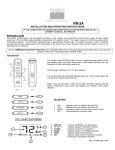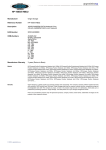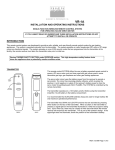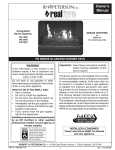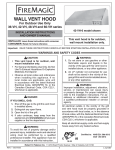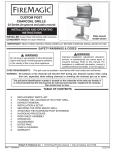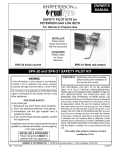Download R.H. Peterson 115 Series Operating instructions
Transcript
VR-2A INSTALLATION AND OPERATING INSTRUCTIONS MULTI-FUNCTION WIRELESS REMOTE CONTROL SYSTEM FOR OPERATING SERVO MOTOR VALVE, MANUALLY AND WITH A THERMOSTAT FUNCTION IF YOU CANNOT READ OR UNDERSTAND THESE INSTALLATION INSTRUCTIONS DO NOT ATTEMPT TO INSTALL OR OPERATE INTRODUCTION This remote control system was developed to provide a safe, reliable, and user-friendly remote control system for gas heating appliances. The system is operated manually from the transmitter. The system operates on radio frequencies (RF) within a 20' range using non-directional signals. The system operates on one of 1,048,576 security codes that are programmed into the transmitter at the factory; the remote receiver's code must be matched to that of the transmitter prior to initial use. Review THERMO SAFETY SECTION under RECEIVER section. This high temperature safety feature shuts down the appliance when a potentially unsafe condition exists. TRANSMITTER WALL CLIP SLOT ON/HI BUTTON ON/HI This remote control SYSTEM offers the user a battery-operated remote control to power up to a 6 VDC servo motor such as those used with gas valves used in some heater rated gas logs, gas fireplaces and other gas heating appliances. The servo motor circuit uses the battery power from the receiver to operate a servo motor. The circuit has reversing polarity software which reverses the positive (+) and negative (-) output of the receiver's battery power to drive the servo motor forward/backward. (HI/LO FLAME) The SYSTEM is controlled by the remote transmitter. MODE BUTTON LO/OFF MODE LO/OFF BUTTON The transmitter operates on a (2) 1.5V AAA batteries. SET It is recommended that ALKALINE batteries always be used for longer battery life and maximum operational performance. SET BUTTON BATTERY COMPARTMENT FRONT Before using the transmitter, install the (2) AAA transmitter batteries into the battery compartment. (Use caution that batteries are installed in the proper direction) BACK ON/HI 1 KEY SETINGS LO/OFF 2 • ON/HI • LO/OFF MODE 3 • • MODE SET SET 4 -Operates unit to on position, Manually operated servo HI. - Operates unit to off position, Manually operated servo LO. - Changes unit from manual mode to thermo mode. - Sets temperature in thermo mode. REV. 1/31/06 Page 1 of 8 LCD - Liquid Crystal Display 2 1 3 4 ROOM SET TEMP 5 1. 2. 3. 4. 5. 6. DISPLAY 0 0 F OR C FLAME ROOM TEMP SET 6 Indicates CURRENT room temperature . Indicates degrees Fahrenheit or Celsius. Indicates burner/valve in operation. Indicates remote is in THERMO operation. Appears during manual operation. Appears during time the of setting the desired temperature in the thermo operation. 0 0 SETTING F / C SCALE 0 0 The factory setting for temperature is F. To change this setting to C, first • Press the ON/HI key and the LO/OFF key on the transmitter at the 0 0 same time this will change from F to C. Follow this same 0 0 procedure to change from C back to F. TEMP MANUAL FUNCTION To operate the system in the manual “MODE” do the following. ON OPERATION TEMP SCREEN DURING ADJUSTING TO ON SCREEN AFTER 3 SECOND DEFAULT Press and hold the ON/HI key until the appliance flame comes on and reaches the desired flame height or is at full on. During this time the LCD screen will show HI, after 3 seconds the LCD screen will default to display room temperature and the word TEMP will show. (Flame icon will appear on LCD screen in manual on mode) OFF OPERATION TEMP SCREEN DURING ADJUSTING TO OFF Press and hold the LO/OFF key until the appliance flame reaches the desire flame height or completely shuts off. During this time the LCD screen will show LO, after 3 seconds the LCD screen will default to display room temperature and the word TEMP will show. SCREEN AFTER 3 SECOND DEFAULT THERMOSTAT FUNCTION SETTING DESIRED ROOM TEMPERATURE This remote control system can be thermostatically controlled when the transmitter is in the THERMO mode (The word ROOM must be displayed on the screen). To set the THERMO MODE and DESIRED room temperature, SET TEMP THERMO SET ROOM TEMP THERMO MODE Press the MODE key until the LCD screen shows the word ROOM, then the remote is in the thermostatic mode. Press and hold the SET key until the desired set temperature is reached. (By pressing and holding the set key the LCD screen set 0 0 0 numbers will increase from 45 to 99 then restart over at 45 ) Next release the SET key. The LCD screen will display the set temperature for 3 seconds and the LCD screen will flash the set temperature for 3 seconds, then the LCD screen will default to display the room temperature. REV. 1/31/06 Page 2 of 8 TO CHANGE THE SET TEMPERATURE ROOM TEMP THERMO ON ROOM TEMP THERMO OFF Press and hold the SET key until the desired set temperature is reached. (By pressing and holding the set key the LCD screen set 0 0 0 numbers will increase from 45 to 99 then restart over at 45 ) Next release the SET key. The LCD screen will display the set temperature for 3 seconds, then will flash the set temperature for 3 seconds, then the LCD screen will default to display the room temperature. Press the MODE key to disengage the thermo mode. The word ROOM on the LCD screen will not show when the thermo is not in operation. 0 0 NOTE: The highest SET temperature is 99 Fahrenheit (32 Celsius) 0 0 and the lowest temperature is (45 Fahrenheit (6 Celsius) OPERATIONAL NOTES: 1. 2. While in the Thermo mode the flame height can be adjusted to a lower than FULL /ON setting if desired by pressing the LO/OFF key. This setting will hold only until the next update of the transmitter. Then the setting will return to FULL/ON. This will not disengage the thermo mode. The transmitter reads changes in room temperature and updates every two minutes. To hold the lower than FULL/ON setting until the next OFF cycle you must manually turn the flame adjustment knob on the control valve to a lower setting. This setting will hold until the room temperature is 2 deg. above the set temperature (OFF cycle) at that time the transmitter will send a signal to the receiver to shut the appliance OFF. At the next ON cycle the appliance will return to FULL/ON. The Thermo Feature on the transmitter operates the appliance whenever the ROOM TEMPERATURE varies a certain number of degrees from the SET TEMPERATURE. This variation is called the “SWING” or TEMPERATURE DIFFERENTIAL. The normal operating cycle of an appliance may be 2-4 times per hour depending on how well the room or home is insulated from the cold or drafts. 0 0 The factory setting for the “swing number” is 2. This represents a temperature variation of +/- 2 F (1 C) between SET temperature and ROOM temperature, which determines when the fireplace will be activated. The transmitter has ON/HI and LO/OFF manual functions that are activated by pressing either button on the face of the transmitter. When a button on the transmitter is pressed the word HI or LO will appear on the LCD screen to show while the signal is being sent. Upon initial use, there may be a delay of three seconds before the remote receiver will respond to the transmitter. This is part of the system's design. REMOTE RECEIVER IMPORTANT THE REMOTE RECEIVER SHOULD BE POSITIONED WHERE AMBIENT TEMPERATURES DO NOT EXCEED 130° F. The remote receiver (right) operates on four 1.5V AA-size batteries. It is recommended that ALKALINE batteries be used for longer battery life and maximum microprocessor performance. IMPORTANT: New or fully charged batteries are essential to proper operation of the remote receiver as a servo motor's power consumption is substantially higher than standard remote control systems. NOTE: The remote receiver will only respond to the transmitter when the 2-position slide button on the remote receiver is in the REMOTE position. The remote receiver houses the microprocessor that responds to commands from the transmitter to control system operation. REV. 1/31/06 Page 3 of 8 FUNCTIONS: 1. 2. 3. 4. 5. With the slide switch in the REMOTE position, the system will only operate if the remote receiver receives commands from the transmitter. Upon initial use or after an extended period of no use, the ON button may have to be pressed for up to three seconds before activating servo motor. If the system does not respond to the transmitter on initial use, see Matching Security Codes. With the slide in the OFF position, the system is off. It is suggested that the slide switch be placed in the OFF position if you will be away from your home for an extended period of time. Placing the slide switch in the OFF position also functions as a safety "lock out" by both turning the system OFF and rendering the transmitter inoperative. INSTALLATION INSTRUCTIONS WARNING DO NOT CONNECT REMOTE RECEIVER DIRECTLY TO 110-120VAC POWER. THIS WILL BURN OUT THE RECEIVER. FOLLOW INSTRUCTIONS FROM MANUFACTURER OF GAS VALVE FOR CORRECT WIRING PROCEDURES. IMPROPER INSTALLATION OF ELECTRIC COMPONENTS CAN CAUSE DAMAGE TO GAS VALVE AND REMOTE RECEIVER. INSTALLATION The remote receiver can be mounted on or near the fireplace hearth. PROTECTION FROM EXTREME HEAT IS VERY IMPORTANT. Like any piece of electronic equipment, the remote receiver should be kept away from temperatures exceeding 130º F inside the receiver case. Battery life is also significantly shortened if batteries are exposed to high temperatures. HEARTH MOUNT The remote receiver can be placed on the fireplace hearth or under the fireplace, behind the control access panel. Position where the ambient temperature inside the receiver case does not exceed 130º F. NOTE: Black Button is used on Hearth Mount Applications. Remote Receiver Wire terminals Receiver Slide Button ADJ. LEARN OFF REMOTE WIRING INSTRUCTIONS CONNECTING THE RECEIVER TO A HI/LOW SERVO MOTOR STYLE VALVE SYSTEM 1. 2. 3. 4. Connect the BLACK 18 gage stranded wire with the 1/4” female terminal from the receiver to the 1/4” male terminal on the valve servo motor. Connect the Black 18 gage stranded wire with the 7/32” female terminal from the receiver to the 7/32” male terminal on the valve servo motor. After receiver wires are connected to the valve servo motor terminals make sure the receiver shield is located over the receiver and then locate the receiver in an area that will not exceed the 130° F. Depending on where the receiver is located it may be necessary to shorten the length of the wires. This can be done by removing the (2) wires from the receiver cutting them to the desired length then reinstalling them into the same connections on the receiver. IMPORTANT NOTE: Operation of these controls is dependent on which wire is attached to which terminal. If operation of control does not correspond to operating buttons on transmitter, reverse wire installation at the receiver or at the control. NOTE: Up to 6 VDC of power is provided at the receiver terminal. REV. 1/31/06 Page 4 of 8 7/32” Female Terminal 1/4” Female Terminal Pilot Adjustment N PIL O T I G SERVO MOTOR O FF 1/4” Female Terminal ON O HI/LO STYLE SERVO MOTOR VALVE N Receiver Slide Button OFF ADJ. LEARN 7/32” Female Terminal (Back of Receiver) OFF REMOTE Remote Receiver 1/4” Male Terminal 7/32” Male Terminal GENERAL INFORMATION THERMO-SAFETY FEATURE - RECEIVER (T/S - RX) When the ambient temperature at the THERMISTOR, inside the receiver case, reaches 130°F, the THERMISTOR will automatically send 10 seconds of power to the down or off terminal on the valve to shut the fireplace system down and the RECEIVER will begin emitting a series of 2 "beeps" every 4 seconds. When the ambient temperature, at the RECEIVER, drops between 120° F and 130° F, the user can reactivate the fireplace by pushing either button on the transmitter. When any transmitter button is pressed, the THERMISTOR "resets" itself and the fireplace will begin operating again. However, the "beeping" will continue, if the ambient temperature remains between 120° F and 130° F. This "beeping" alerts the user that the RECEIVER should be repositioned so the ambient temperature drops below 120° F. When the temperature drops below 120° F, the "beeping" will cease, providing the user has "reset" the THERMISTOR by pushing either transmitter button to operate the fireplace. Allow sufficient time for receiver to cool below 120° F, and then press transmitter button to stop beeping. CP (CHILDPROOF) FEATURE This remote control includes a CHILDPROOF “LOCK-OUT” feature that allows the user to “LOCK-OUT” operation of the appliance, from the TRANSMITTER. SETTING “LOCK-OUT” –(CP) • • • To activate the “LOCK-OUT” feature, press and hold the ON/HI button and the MODE button at the same time for 5 seconds. The letters CP will appear in the TEMP frame on the LCD screen. To disengage the “LOCK-OUT”, press and hold the ON/HI button and the MODE button at the same time for 5 seconds and the letters CP will disappear from the LCD screen and the transmitter will return to its normal operating condition. To verify that transmitter is in the CP lock-out mode press any key and the LCD screen will show “CP” NOTE: If the appliance is already operating in the ON or THERMO MODES, engaging the “LOCK-OUT” will not cancel the operating MODE. Engaging the “LOCK-OUT” prevents only the manual operation of the TRANSMITTER. If in the auto modes, the THERMO operation will continue to operate normally. To totally “LOCK-OUT” the operation of the TRANSMITTER’S operating signals; the transmitter’s MODE must be set to OFF. REV. 1/31/06 Page 5 of 8 MATCHING SECURITY CODES Each transmitter can use one of 1,048,576 unique security codes. It may be necessary to program the remote receiver to LEARN the security code of the transmitter upon initial use, if batteries are replaced, or if a replacement transmitter is purchased from your dealer or the factory. When matching security codes, be sure slide button on the receiver is in the REMOTE position; the code will NOT "LEARN" if the slide switch is in the OFF position. Program the remote receiver to LEARN a new security code Push and Release the LEARN button on the top of the remote receiver then Press any button on the transmitter. A change in the beeping pattern, at the receiver, indicates the transmitter's code has been programmed into the receiver. When an existing receiver is matched to a new transmitter, the new security code will overwrite the old one. The microprocessor that controls the security code matching procedure is controlled by a timing function. If you are unsuccessful in matching the security code on the first attempt, wait 1 - 2 minutes before trying again--this delay allows the microprocessor to reset its timer circuitry--and try up to two or three more times. TRANSMITTER WALL CLIP The transmitter can be hung on a wall using the clip provided. If the clip is installed on a solid wood wall, drill 1/8" pilot holes and install with the screws provided. If it is installed on a plaster/wallboard wall, first drill two 1/4" holes into the wall. Then use a hammer to tap in the two plastic wall anchors flush with the wall; then install the screws provided. WALL CLIP SLOT WALL CLIP BATTERY COMPARTMENT BATTERY LIFE Life expectancy of the alkaline batteries in the VR-2A can be up to 12 months depending on use of the servo function. Replace all batteries annually. When the transmitter no longer operates the remote receiver from a distance it did previously (i.e., the transmitter's range has decreased) or the remote receiver does not function at all, the batteries should be checked. It is important that the remote receiver batteries are fully charged, providing combined output voltage of at least 4.5volts. The transmitter should operate with as little as 2.5 volts battery power. NOTE: Extensive use of the SERVO MOTOR setting will reduce the receiver's battery life significantly. TROUBLE SHOOTING If you encounter problems with your appliance system, the problem may be with the appliance itself or it could be with the VR-2A remote system. Review the fireplace manufacturer's operation manual to make sure all connections are properly made. Then check the operation of the remote in the following manner: 1. 2. 3. 4. 5. • Make sure the batteries are correctly installed in the RECEIVER. One reversed battery will keep receiver from operating properly. Check battery in TRANSMITTER to make sure contacts are touching (+) and (-) ends of battery. Bend metal contacts in for tighter fit. Be sure RECEIVER and TRANSMITTER are within 20'-25' operating range. Keep RECEIVER from temperatures exceeding 130° F. Battery life shortened when ambient temperatures are above 115° F. If RECEIVER is installed in tightly enclosed metal surround, the operating distance will be shortened. NOTE: A receiver located in an area, where the ambient temperature inside the case exceeds 130° F, will cause the THERMOSAFETY feature to cut in, requiring you to reposition the receiver to stop the warning beeps, and to "reset" the receiver's operation. Due to handling and shipping of the unit, handling or dropping of the transmitter by the customer, and/or heat conditions at the receiver, some receivers may need an occasional frequency adjustment. This adjustment is made to improve the communication and operating distance between the transmitter and the receiver. Follow the steps below for making the adjustment. REV. 1/31/06 Page 6 of 8 FREQUENCY (DISTANCE) ADJUSTMENT PROCEDURE RECEIVER ADJUSTMENT 1. 2. To adjust at the receiver, use a small slotted screwdriver. Turn the adjustment (ADJ) screw counter-clockwise about 5° or maximum of 1/8 turn. This should correct the distance problem. If that does not correct the problem, return adjustment screw to original position and then turn adjustment screw clockwise. This adjustment is like tuning your radio. If you keep turning the adjustment screw, in either direction, you will go past the proper setting (tuning). SPECIFICATIONS BATTERIES: Transmitter (2) 1.5 volt AAA t bateries Remote Receiver 6V - 4 ea. AA 1.5 Alkaline FCC ID No.'s: transmitter - K9L1003TX; receiver - K9L300IRX Operating Frequency: 303.8 MHZ Canadian IC ID No.'s: transmitter – 2439-1003TX; receiver - 2439 102 728A FCC REQUIREMENTS NOTE: THE MANUFACTURER IS NOT RESPONSIBLE FOR ANY RADIO OR TV INTERFERENCE CAUSED BY UNAUTHORIZED MODIFICATIONS TO THIS EQUIPMENT. SUCH MODIFICATIONS COULD VOID THE USER’S AUTHORITY TO OPERATE THE EQUIPMENT. REV. 1/31/06 Page 7 of 8 Warranty Covering R. H. Peterson Company Remote Controls This warranty is for the original purchaser of the product and is non-transferable. This warranty applies to products purchased for residential purposes. Please keep a copy of your sales slip as you will be asked to show proof of purchase for warranty claims. Should any part fail because of defective workmanship or material within one year of the original date of retail purchase, R.H. Peterson Company will repair or, at R.H. Peterson’s option, replace the defective parts. This warranty does not cover parts becoming defective by misuse, accidental damage, electrical damage, improper handling and/or installation or service (log sets, burners and remote controls must be installed as outlined in the enclosed instructions by a qualified, professional installer and with only Peterson parts, control valves, remotes and accessories). This warranty does not cover labor or labor-related charges. It specifically excludes liability for indirect, incidental or consequential damages. Some States do not allow the exclusion or limitation of incidental or consequential damages, so the above exclusion or limitation may not apply to you. This warranty gives you specified legal rights and you may have other rights which may vary from state, province or nation. For additional information regarding this warranty, or information on how to place a warranty claim, contact your Peterson dealer or the Robert H. Peterson Company. ROBERT H. PETERSON CO. 14724 EAST PROCTOR AVENUE CITY OF INDUSTRY, CALIFORNIA 91746 WWW.RHPETERSON.COM When contacting your Peterson dealer or the Robert H. Peterson Company please provide the following information: -Name, Address, Telephone Number of Owner -Date of Purchase, Proof of Purchase -Model Name, Date Code -Any relevant information or circumstances, e.g. installation, mode of operation when defect was noted. Warranty claim processing requires all of the above information. The Robert H. Peterson Company will reserve the right to physically inspect the product for defects by authorized representatives. ______________________________________________________________________________________ Purchase Date: ____________________ Model: __________________ Date Code: ________________ Purchased From: ____________________________________ Date: ______________________________ Name: ________________________________________________________________________________ Address: ______________________________________________________________________________ City: _________________________________ State/Province: ____________Zip/Postal Code __________ REV. 1/31/06 Page 8 of 8








